The roots of copywriting extend far into history, evidenced by promotional pamphlets discovered in Pompeii and even interpretations of cave drawings as early advertising. Copywriting has transformed from cryptic images on walls to global messages and is now ubiquitous in our surroundings.
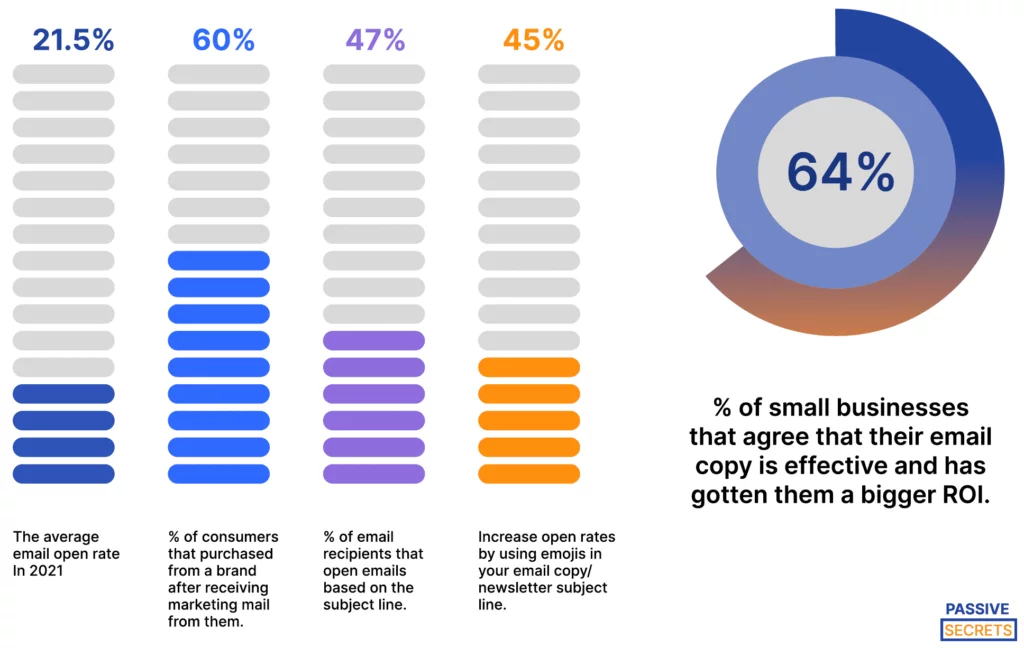
Types of Copywriting:
1. Marketing copywriting
Marketing copywriting is the cornerstone of advertising campaigns, encompassing a wide array of promotional content that people encounter daily. This form of copywriting is designed to capture attention, evoke emotions, and ultimately persuade consumers to take action, whether it’s making a purchase, signing up for a service, or engaging with a brand.
The mediums through which marketing copywriting is delivered are diverse and ever-evolving, reflecting advancements in technology and changes in consumer behavior. Here’s a detailed breakdown of some common channels for marketing copywriting:
- Online Display Ads: These are the banner ads, pop-ups, and sponsored content that appear on websites and social media platforms. They often feature compelling visuals, catchy headlines, and concise messaging to attract clicks and drive traffic to a specific website or landing page.
- YouTube Videos: Video has become a dominant force in digital marketing, and YouTube is a prime platform for brands to showcase their products or services. Marketing copy in video form can range from product demonstrations and testimonials to entertaining commercials and influencer collaborations.
- Radio Commercials: Despite the rise of streaming services and podcasts, radio remains a popular medium for advertising, especially for local businesses. Radio ads leverage storytelling, sound effects, and memorable jingles to create brand recognition and drive listener engagement.
- TV Commercials: Television advertising continues to be a powerful way for brands to reach mass audiences. TV commercials often feature high production values, celebrity endorsements, and creative storytelling to leave a lasting impression on viewers and influence their purchasing decisions.
- Flyers: These printed materials are commonly used for local marketing efforts, such as promoting sales, events, or new business openings. Flyers typically include eye-catching graphics, limited-time offers, and clear calls to action to entice recipients to visit a store or website.
- Billboards: Outdoor advertising and signage on billboards are effective ways to reach consumers on the go. Billboards rely on bold imagery, succinct messaging, and strategic placement to capture attention and leave a memorable impression during daily commutes or leisure activities.
- Branded Stickers: In the digital system, branded stickers have become a popular form of marketing copy on messaging apps and social media platforms. These stickers feature brand logos, slogans, or characters and are often shared among users, increasing brand visibility and fostering community engagement.
- Direct Mail: Despite the prevalence of digital marketing, direct mail campaigns remain relevant for reaching specific target audiences. Direct mail pieces, such as postcards, catalogs, and personalized letters, leverage targeted messaging and offers to drive customer response and conversions.
EXAMPLE:

Kate Spade’s Facebook ad exemplifies effective marketing copywriting with its strategically crafted text positioned at the top of the ad. By employing lowercase type, they maintain their brand’s casual yet sophisticated writing style. Additionally, the immediate offer of a discount serves as a powerful incentive to prompt viewers to click on the ad, highlighting the advertisement’s clear intent to drive purse sales.
2. SEO copywriting
SEO copywriting is a specialized form of writing that focuses on optimizing content to improve its visibility and ranking in search engine results pages (SERPs). Here’s a detailed breakdown of its key features:
- Keyword Research: SEO copywriting begins with comprehensive keyword research to identify terms and phrases that are relevant to the topic or theme of the content. This involves analyzing search volume, competition, and user intent to select the most effective keywords to target.
- Strategic Keyword Placement: Once the target keywords are identified, they are strategically incorporated into the content. This includes placing keywords in prominent areas such as the title, headings, meta tags, and throughout the body of the text. However, it’s important to maintain a natural flow and readability, avoiding keyword stuffing which can have a negative impact on user experience and search engine rankings.
- Quality Content: High-quality, engaging content is essential for effective SEO copywriting. Search engines prioritize content that is informative, relevant, and valuable to users. Therefore, SEO copywriters focus on creating content that addresses the needs and interests of their target audience while also incorporating targeted keywords seamlessly.
- Optimized Meta Tags: Meta tags, including meta titles and meta descriptions, play a crucial role in SEO. SEO copywriters ensure that these tags accurately reflect the content of the page and include relevant keywords to improve click-through rates and search engine visibility.
- Internal and External Linking: Incorporating internal links to other pages within the website and external links to authoritative sources helps to establish credibility and improve the overall SEO performance of the content. SEO copywriters strategically place links within the text to enhance navigation and provide additional context for readers and search engines.
- Optimized Images: Images can also be optimized for SEO by using descriptive filenames, alt text, and captions that include relevant keywords. This helps search engines understand the content of the images and improves the likelihood of them appearing in image search results.
- Regular Updates and Maintenance: SEO is an ongoing process, and SEO copywriting requires regular updates and maintenance to remain effective. This may involve revisiting and refreshing existing content, monitoring keyword performance, and staying informed about changes to search engine algorithms and best practices.
EXAMPLE:
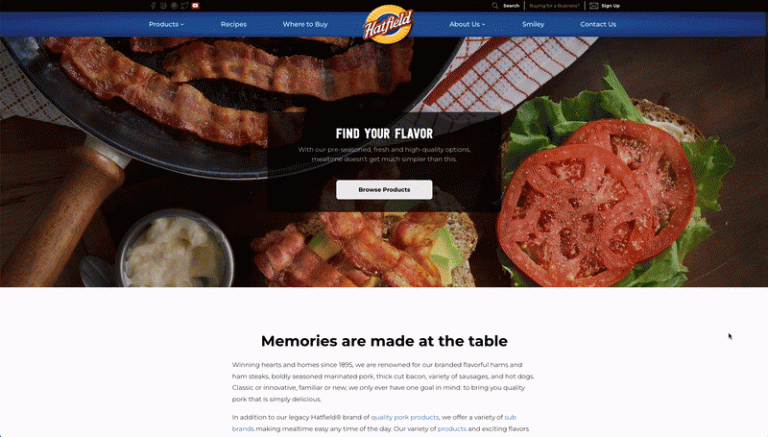
By effectively leveraging these SEO copywriting techniques, the Hatfield page successfully promotes the company’s products while also optimizing its visibility and ranking on SERPs. This holistic approach to SEO copywriting not only drives organic traffic to the page but also enhances the overall online presence and competitiveness of the Hatfield brand.
3. Email copywriting
Email marketing is a powerful tool for businesses to directly engage with their most targeted audience. Among the myriad benefits of email marketing, one of the most impactful is the ability to craft compelling email copy that resonates with recipients. Here’s a detailed exploration of why great email copy is essential and the key elements involved:
- Direct Connection with Audience: Unlike other marketing channels, email marketing allows businesses to communicate directly with their audience in a personalized and intimate manner. Great email copy enables businesses to establish a genuine connection with recipients, addressing their needs, interests, and pain points directly.
- Building Relationships: Effective email copywriting is instrumental in building and nurturing relationships with customers. By delivering relevant and valuable content, businesses can cultivate trust and loyalty among their subscribers, ultimately leading to increased engagement, conversions, and customer lifetime value.
- Driving Conversions: The primary goal of email marketing is often to drive conversions, whether it’s making a purchase, signing up for a webinar, or downloading a resource. Great email copy is persuasive and compelling, encouraging recipients to take the desired action by highlighting the benefits, urgency, and value proposition effectively.
Now, let’s delve into the key elements of great email copywriting:
- A Great Subject Line: The subject line is the first thing recipients see when they receive an email, making it crucial for grabbing their attention and enticing them to open the email. A great subject line is concise, intriguing, and relevant to the content of the email. It should spark curiosity, convey urgency, or offer a compelling benefit to encourage opens.
- A Thoughtful Preview Sentence: The preview sentence, also known as the preheader text, appears alongside the subject line in the recipient’s inbox. It provides additional context and complements the subject line, enticing recipients to open the email for more information. A thoughtful preview sentence builds on the subject line, offering a sneak peek of the content inside and reinforcing the value proposition.
- An Intro Sentence for the Body: Once recipients open the email, the introduction sets the tone and captures their interest from the outset. The intro sentence should be concise, engaging, and relevant to the recipient’s needs or interests. It should establish a connection with the reader and pique their curiosity, motivating them to continue reading.
- A Compelling Call-to-Action (CTA): The CTA is the linchpin of effective email copywriting, guiding recipients towards the desired action. Whether it’s making a purchase, registering for an event, or downloading a resource, the CTA should be clear, actionable, and persuasive. It should communicate the benefit of taking action and create a sense of urgency or excitement to spur immediate engagement.
EXAMPLE:

This email from Wanderlust promotes the company’s meditation webinar with an attention-grabbing subject line: “Don’t hesitate, meditate!” This compelling subject line is designed to stand out in crowded inboxes and entice recipients to open the email.
The email features an image that highlights key details of the webinar, including the title, duration, and host’s name. Beneath this, an eye-catching headline encourages subscribers to continue reading, drawing them into the content.
Learn about how humans and search engines can be affected by effective copywriting.

4. Social media copywriting
There are numerous social media platforms available for communicating with your audience, each offering unique features and demographics. Conducting research to identify where your customers are most active can help tailor your message effectively.
Once you’ve determined the preferred platforms of your audience, you can customize the voice and tone of your social media copywriting to resonate with them. Here’s a detailed exploration of the distinctive elements of writing social media copy:
- Emojis Usage: Emojis are widely embraced and play a significant role in social media communication. Incorporating emojis into your copy can add personality, emotion, and visual appeal, enhancing engagement with your audience.
- Informal Tone: Social media audiences typically respond well to a casual and conversational tone. Using language that feels natural and relatable helps foster a connection with your followers and encourages interaction.
- Visual Component: Social media copywriting often accompanies visual content, such as images, videos, or infographics. Pairing your copy with visually appealing elements enhances its impact and reinforces your message effectively.
- Paid Advertising: Social media platforms offer robust advertising options, allowing businesses to reach a broader audience through paid ads. Writing copy for paid ads requires consideration of platform-specific ad formats, targeting options, and campaign objectives.
- Platform-Specific KPIs: Key performance indicators (KPIs) vary across different social media platforms. Metrics such as likes, shares, comments, and click-through rates may hold varying degrees of importance depending on the platform and campaign goals.
- Direct Website Redirect: Social media ads often direct users to a website’s landing page or specific product page. Therefore, the copy should prompt users to take action and clearly communicate the value proposition of clicking through to the destination.
- Brevity: With the limited attention span of social media users, concise copy is essential. Capturing attention quickly and conveying the message succinctly increases the likelihood of engagement and conversion.
EXAMPLE:

Smashburger is recognized for its humorous and charming social media presence, appealing to a younger demographic of fast-casual diners who have a passion for delicious food. While the restaurant often shares images of young families savoring a Smash burger meal, accompanied by brand-specific messaging, they also incorporate comedic copywriting to connect with their audience.
5. Website copywriting
Website copywriting plays a pivotal role in engaging and informing visitors at various stages of the customer journey, from initial awareness to eventual conversion. Whether it’s crafting compelling articles to introduce a product or creating targeted landing pages tailored to specific audiences, companies across industries rely on website copywriting to effectively communicate their offerings.
Here’s a detailed exploration of the best practices and considerations adopted by website copywriters:
- Brand Tone: Maintaining consistency with the brand’s tone and voice is crucial for establishing a cohesive identity and fostering brand recognition. Whether the tone is formal, friendly, or humorous, website copywriters ensure that every piece of content reflects the brand’s personality and values.
- SEO-Friendliness: Incorporating search engine optimization (SEO) techniques into website copywriting helps improve visibility and ranking on search engine results pages (SERPs). This involves strategic placement of relevant keywords, optimizing meta tags, and creating content that addresses user search queries effectively.
- CTAs (Call-to-Action): Effective CTAs prompt visitors to take specific actions that align with the business objectives, whether it’s subscribing to a newsletter, requesting a demo, or making a purchase. Website copywriters strategically place CTAs throughout the site to guide visitors through the conversion funnel and encourage engagement.
In addition to these best practices, excellent website copywriting goes beyond merely conveying information. It also strives to evoke emotion, build trust, and compel action. Here’s how:
- Clear Messaging: Clear and concise messaging ensures that visitors understand the brand’s value proposition and offerings. Website copywriters distill complex concepts into digestible content that resonates with the target audience.
- Encouraging Engagement: Effective website copywriting encourages visitors to take the next step in their journey, whether it’s exploring additional content, signing up for updates, or making a purchase. By addressing pain points and highlighting benefits, copywriters motivate readers to engage further with the brand.
- Guiding Through the Funnel: Website copywriting plays a crucial role in guiding visitors through the sales funnel, from initial awareness to conversion. By crafting content that educates, informs, and persuades, copywriters help move prospects closer to making a purchasing decision.
Here’s a detailed exploration of how website copywriters employ best practices and considerations to create compelling content:
- Top-of-Funnel Appeal: At the top of the funnel, website copywriters focus on creating high-level, engaging articles that introduce products or services to potential customers. These articles aim to capture attention, generate curiosity, and provide valuable information that educates and informs readers about the brand’s offerings.
- Highly Targeted Service Landing Pages: On the other end of the spectrum, highly targeted service landing pages are designed to speak directly to individuals at the bottom of the funnel who are close to making a purchasing decision. These landing pages feature tailored messaging, persuasive content, and clear calls-to-action (CTAs) to encourage conversions.
- Best Practices and Considerations: Website copywriters adhere to a set of best practices and considerations to ensure the effectiveness of their content. This includes maintaining consistency with the brand’s tone and voice, optimizing content for search engines (SEO-friendliness), and incorporating relevant CTAs that guide visitors towards desired actions.
- Conveying Clear Message: Excellent website copywriting goes beyond mere information dissemination; it conveys a clear and compelling message about the brand and its products or services. Copywriters distill complex concepts into concise, easy-to-understand language that resonates with the target audience and communicates the brand’s value proposition effectively.
- Encouraging Action: In addition to informing and engaging readers, website copywriting aims to encourage action. Whether it’s signing up for an email list, considering a subscription, or making a purchase, copywriters strategically position CTAs throughout the content to prompt readers to take the next step in their journey down the sales funnel.
EXAMPLE:
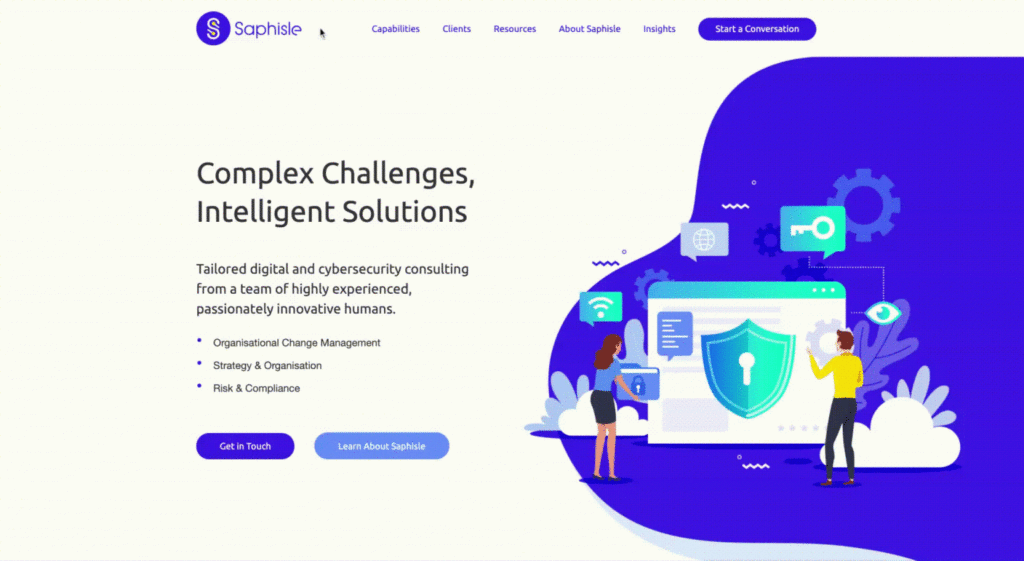
Saphisle’s website copywriting presents a comprehensive service offering in straightforward, engaging language, complemented by distinct calls-to-action (CTAs). The layout of the copy is strategically designed to guide readers to the landing page that aligns with their position on the consumer funnel, facilitating seamless navigation and enhancing user experience.
6. Direct response copywriting
Direct Response Copywriting is a strategic form of communication designed to prompt immediate action from the recipient. It encompasses any type of copy that compels the audience to take action without delay.
Here’s a detailed breakdown of where direct response copywriting is commonly used:
- Landing Pages: Direct response copywriting is often deployed on landing pages that users land on after clicking on an advertisement. The copy on these pages is crafted to persuade visitors to take a specific action, such as making a purchase, signing up for a newsletter, or requesting more information.
- Open-ended Emails: In email marketing, direct response copywriting can be found in open-ended emails that encourage recipients to engage further with the content or to respond directly. These emails typically feature clear calls-to-action and compelling messaging designed to prompt immediate interaction.
- Pop-ups: Pop-up messages on websites often utilize direct response copywriting to capture the attention of visitors and encourage them to take action, such as subscribing to a newsletter, claiming a special offer, or downloading a resource. The copy in these pop-ups is concise, persuasive, and focused on driving conversions.
- Limited Time Offer Explanations: Direct response copywriting is also prevalent in explanations of limited-time offers or promotions. Whether it’s on a website, email, or advertisement, the copy effectively communicates the urgency and value of the offer, compelling recipients to act quickly before the opportunity expires.
EXAMPLE:

On Nuuly’s landing page, you’ll notice their prominently displayed logo, slogan, and multiple calls-to-action (CTAs) urging visitors to take action. The “Join Now” button serves as a direct response mechanism, guiding customers through the sales process effectively.
Additionally, as customers navigate a website, they may encounter pop-ups before transitioning to a new page or exiting the site. These pop-ups serve as another form of direct response, encouraging visitors to remain on the page by enticing them to sign up for the company’s offerings.
7, Brand copywriting
Brand copywriting is essential for defining your brand identity, gaining industry recognition, and fostering connections with customers. Through strategic writing, you can shape a unique brand image that resonates with your target audience.
Key features of brand copywriting include:
- Brand Identity Definition: Brand copywriting helps articulate what your brand represents, setting you apart from competitors and establishing a distinct identity in the marketplace.
- Recognition Building: By crafting compelling messaging and visuals, brand copywriting contributes to building recognition for your brand within your industry and among consumers.
- Connection with Customers: Effective brand copywriting enables you to connect with your target audience on a deeper level, conveying your brand’s values, personality, and story in a way that resonates with them.
- Versatile Forms: Brand copywriting can manifest in various forms, including logos, slogans, theme songs, and brand personality traits, offering flexibility in how you communicate your brand’s message.
- Emotional Impact: A key aspect of brand copywriting is its ability to evoke emotions and associations that resonate with your audience, fostering positive perceptions and building affinity for your brand.
EXAMPLE:

8. Public relations copywriting
Public Relations Copywriting serves as a strategic communication tool aimed at informing media publications and the public while promoting a business, product, or service. This specialized form of writing follows a uniform structure and adopts a journalistic voice to effectively convey key messages to target audiences.
Key features of Public Relations Copywriting include:
- Informative Content: PR copywriting focuses on providing factual and relevant information to media outlets and the public, ensuring clarity and accuracy in conveying the intended message.
- Promotional Directive: The primary goal of PR copywriting is to promote a business, product, or service to the target audience, highlighting its unique selling points, benefits, and value proposition.
- Written by Specialists: Public Relations Copywriting is typically handled by trained PR specialists who possess the expertise and skills required to craft compelling and persuasive content that resonates with the target audience.
- Media Outreach: PR specialists distribute the written content to various media outlets, including newspapers, magazines, online publications, and broadcast channels, aiming to garner media coverage and generate publicity for the organization or event.
- Uniform Structure: PR copywriting follows a consistent structure, including elements such as a headline, lead paragraph, body content with supporting details, and a concluding paragraph. This ensures coherence and readability across different media platforms.
- Journalistic Voice: PR copywriting adopts a journalistic tone and style, adhering to journalistic principles of objectivity, fairness, and impartiality. This helps enhance credibility and trustworthiness in the eyes of the audience and media professionals.
EXAMPLE:
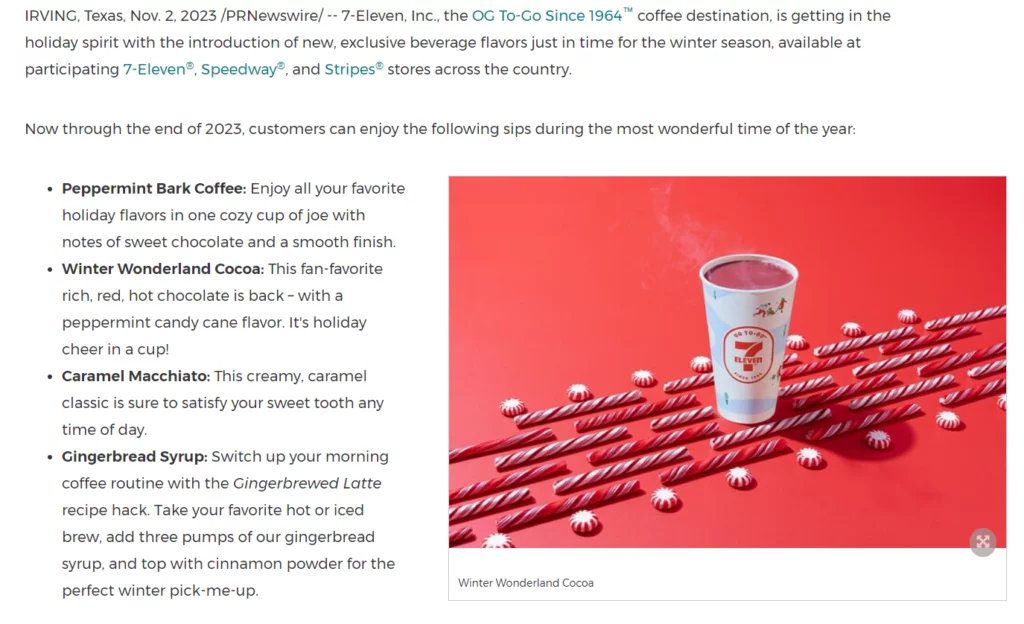
Public relations copywriting is often distributed through platforms like PR Newswire, but the same story has the potential to be featured by news outlets and radio shows if it garners interest. This form of communication aims to establish and nurture relationships between the public and organizations through direct engagement with news media outlets.
8. Thought leadership copywriting
Thought Leadership Copywriting involves the creation of content typically authored by a prominent figure within an industry or field. This content, often in the form of articles or opinion pieces, aims to establish the author as a recognized authority and influential voice on a particular topic or issue.
Key features of Thought Leadership Copywriting include:
- Prominent Figure Authorship: Thought leadership content is typically authored by individuals who hold significant expertise, influence, or experience within their respective industries. These figures may include CEOs, industry experts, researchers, or innovators who possess unique insights and perspectives.
- B2C and General Audience Focus: Thought leadership copywriting is versatile and can target both business-to-consumer (B2C) markets and the general public. The content is tailored to resonate with the intended audience, whether it consists of consumers seeking information or a broader audience interested in industry trends and insights.
- Utilization of Established News Mediums: Thought leadership content is often disseminated through well-known news mediums, such as reputable publications, online platforms, or industry-specific journals. Leveraging established channels enhances the credibility and visibility of the author’s opinions and insights.
- Amplification of Expert Opinions: Thought leadership copywriting serves to amplify the author’s opinions, viewpoints, and expertise on a particular issue or topic. By articulating informed perspectives and offering valuable insights, the author establishes themselves as a trusted authority and influencer within their field.
- Authority Establishment: Through thought leadership content, authors aim to solidify their authority and credibility within their respective industries. By consistently delivering valuable and insightful content, authors can position themselves as thought leaders, garnering respect, recognition, and trust from their audience.
EXAMPLE:
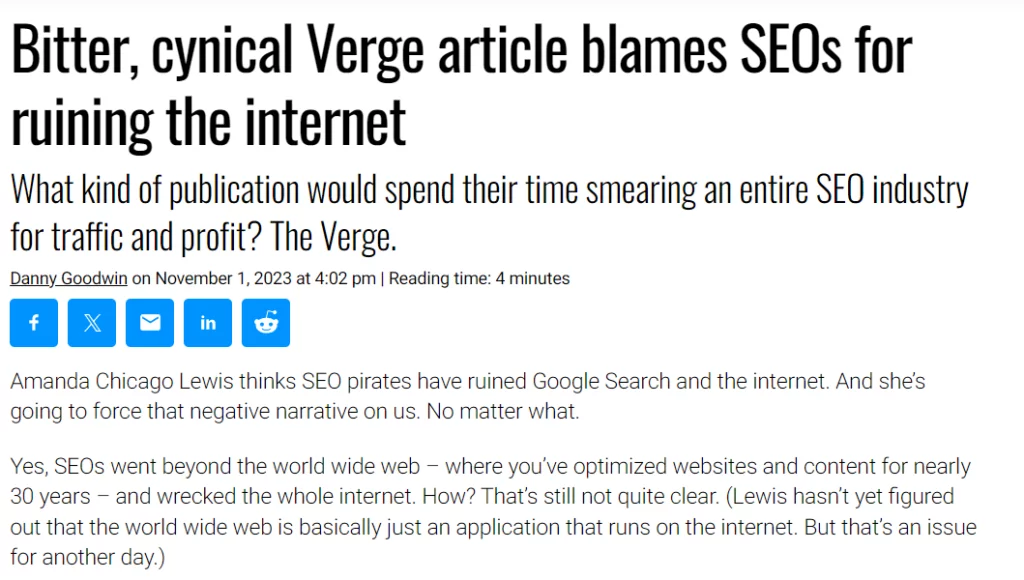
Consider this article featured on Search Engine Land, where Danny Goodwin, the Managing Editor, offers a rebuttal to a piece by The Verge that wrongly implicates SEO specialists in the decline of the internet. In addition to refuting the claims, the article provides Danny Goodwin with a platform to demonstrate thought leadership in the field of SEO.
While thought leadership copywriting does not involve direct sales, it does aim to persuade readers to embrace a specific viewpoint or belief on a particular subject.
10. Product and sales copywriting
Product and sales copywriting encompasses various forms of communication aimed at promoting and selling products or services. This includes online product descriptions, brochures, product catalogs, packaging labels, and other marketing materials designed to influence purchasing decisions.
In traditional media, such as newspapers, magazines, and print media, the fundamentals of product and sales copywriting remain largely unchanged. However, the channels through which these messages are delivered may have evolved with the rise of digital platforms.
Key features of product and sales copywriting include:
- Persuasive Messaging: The primary objective of product and sales copywriting is to craft compelling messages that persuade consumers to make a purchase. This involves highlighting the benefits, features, and value propositions of the product or service in a persuasive manner.
- Consumer Understanding: Effective product and sales copywriting requires a deep understanding of the target audience. Copywriters must identify consumer needs, preferences, and pain points to tailor their messaging accordingly and resonate with potential buyers.
- Multichannel Approach: Product and sales copywriting extends across various channels, including online platforms, print media, and retail environments. Copywriters adapt their messaging to suit the specific characteristics and requirements of each channel.
- Call-to-Action (CTA): A crucial element of product and sales copywriting is the inclusion of a clear call-to-action (CTA) that prompts the reader to take the desired action, such as making a purchase, signing up for a newsletter, or requesting more information.
- Brand Consistency: Consistency in messaging and branding is essential for building trust and recognition with consumers. Product and sales copywriting aligns with the overall brand identity and tone to maintain a cohesive brand image across all touchpoints.
EXAMPLE:
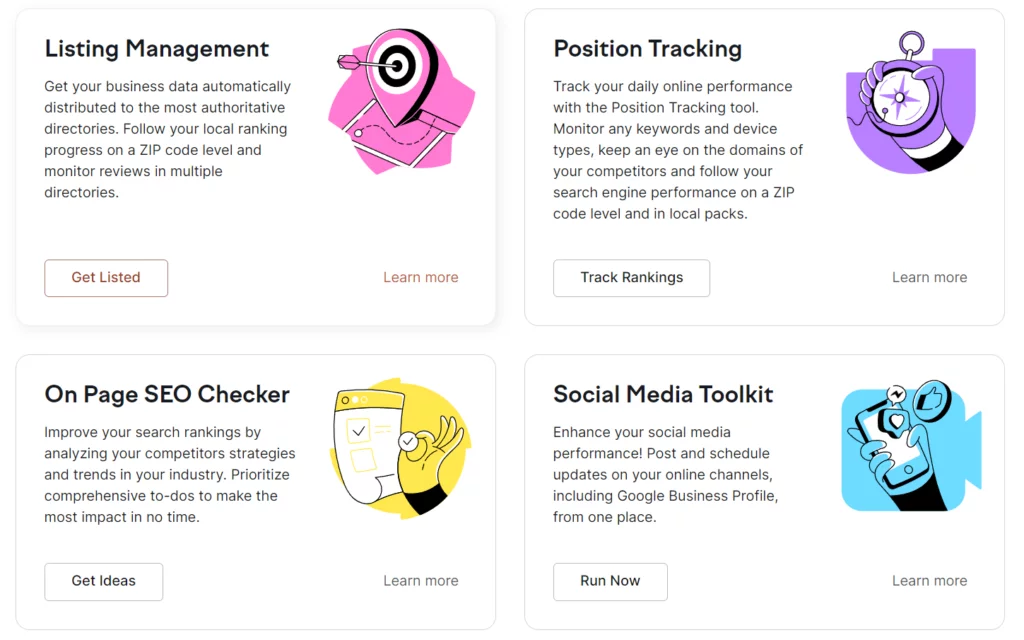
Semrush’s product catalog is meticulously crafted, offering concise descriptions that are easy to navigate and supplemented with action-oriented, persuasive language. Through their adept copywriting, businesses gain a clear understanding of the benefits they stand to derive from Semrush’s service offerings. The catalog strategically incorporates direct calls-to-action (CTAs), encouraging businesses to take immediate action and explore the value that Semrush can bring to their operations.
11. Technical copywriting
Technical copywriting is a specialized craft aimed at elucidating intricate technological concepts, such as cloud-based technology, while simultaneously promoting specific products or services, like IBM’s innovative Mono2Micro solution. It serves as a critical bridge between the complexities of technology and the needs of potential customers, playing a pivotal role in driving sales and fostering innovation within the tech industry.
Key elements of technical copywriting include:
- Clarity and Explanation: The primary goal of technical copywriting is to provide clear and comprehensive explanations of the features and functionalities of a product or service. Copywriters must effectively communicate what the product is, how it works, and why it offers value to potential customers, even those without technical expertise.
- Persuasion and Differentiation: Beyond mere explanation, technical copywriting aims to persuade potential customers to choose a particular product over competing alternatives. Copywriters employ persuasive language and compelling arguments to highlight the unique benefits and advantages of the product, showcasing its superiority and addressing customer pain points.
- Customer-Centric Approach: Successful technical copywriting requires a deep understanding of the target audience’s needs, preferences, and challenges. Copywriters must tailor their messaging to resonate with the specific concerns and interests of potential customers, ensuring relevance and effectiveness.
- Education and Empowerment: Technical copywriting serves an educational role, empowering customers to make informed decisions about the products or services they purchase. By providing detailed information and insights, copywriters enable customers to evaluate the benefits and drawbacks of a product and assess its suitability for their needs.
- Industry Expertise: Effective technical copywriting often requires a high level of expertise and familiarity with the technology and industry in question. Copywriters must stay abreast of the latest developments, trends, and innovations within the tech sector to deliver accurate and compelling content that resonates with customers.
EXAMPLE:

Here’s a sales page showcasing IBM’s Cloud Infrastructure. Contrary to clothing brands like Nuuly or SunChild, IBM’s page includes an FAQ section. The absence of such sections in clothing brands is understandable given the straightforward nature of clothing products. However, for complex services like IBM’s new cloud offerings, customers often seek additional information to understand how the service meets their specific needs before making a purchase decision.
Conclusion:
Effective copywriting is not just about stringing words together; it’s about crafting compelling narratives that resonate with the target audience and drive desired actions. By understanding the nuances of different types of copywriting, businesses can tailor their messaging to suit specific platforms, channels, and objectives. Whether it’s creating engaging social media posts, persuasive sales copy, informative blog articles, or captivating product descriptions, mastering the art of copywriting can significantly enhance brand communication and customer engagement.
FAQs on Types of Copywriting:
How does copywriting differ across various platforms?
Copywriting varies across different platforms based on the audience demographics, user behavior, and communication objectives. For example, copy for social media may be more concise and engaging, while website copy may provide more detailed information about products or services.
What are some common mistakes to avoid in copywriting?
Common mistakes in copywriting include being too salesy or promotional, using jargon or complex language that the audience may not understand, neglecting to proofread for errors, failing to address the audience’s pain points, and lacking a clear call-to-action.
How can businesses improve their copywriting skills?
Businesses can improve their copywriting skills by investing in training or workshops, studying successful copywriting examples, conducting audience research to understand their preferences and pain points, soliciting feedback from customers, and continuously testing and refining their copywriting strategies.



